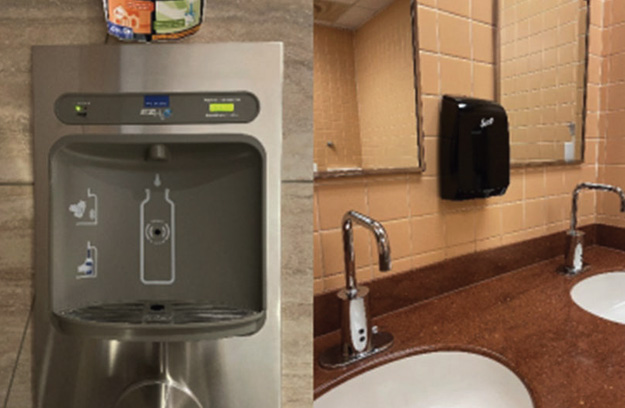
COVID-19 and other infection diseases are spread through close contact with an infected person via respiratory droplet. However, viruses and other pathogens can survive on surfaces infected by droplets as well. Maintaining good cleaning protocols and reducing surface contact can help NIEHS maintain organizational resilience by helping to reduce the risk of infection.
While sanitizing surfaces is critical to interrupting the spread of infectious diseases, cleaning products may contain ingredients which can be hazardous to human health and the environment. Given the mission of NIEHS, it is imperative to ensure use low hazard cleaning products.
Support Handwashing
NIEHS improved hygiene on campus by installing fragrance-free soap in hands free soap dispensers with sealed disposable soap cartridges to prevent bacterial growth at each handwashing station. The soap dispensers are inspected daily and refilled as needed. Additionally touchless paper towel dispensers were installed for hand drying. Signage designed by the World Health Organization detailing handwashing best practices were installed as well.

Reduce Surface Contact
NIEHS reduced surface contact through managing what surfaces required touching. Touchless faucets, soap and paper towel dispensers were installed in every bathroom on campus. Regularly used pedestrian entry doors had hands free operation installed by use of electric motion sensors. All trash, recycling and reuse bins were replaced with hands free operation. Near high touch surfaces that could not be removed such as hand railings, doors and elevators, hand sanitizing stations are located to ensure building occupants maintain proper hand hygiene.

Improved Cleaning Practices
NIEHS already had a rigorous cleaning protocol; however, in light of the current climate, the protocol was improved. The goal of the NIEHS cleaning plan is to provide cleaning and disinfection requirement while reducing the exposure of the occupants and maintenance personnel to pathogens, allergens, and harmful cleaning chemicals which adversely impact air quality, health, finishes, building systems and the environment. High touch surfaces are cleaned three times a day: morning, after lunch and evening by a night crew.
Select Preferred Cleaning Products

Given the nature of the mission and research of the NIEHS, the use of chemicals in cleaning products is strictly reviewed. All cleaning, disinfecting and sanitization products used on the NIHES have been reviewed and do not contain ingredients in section 3 of the SDS which are classified as category 1, 1A or 1B health hazards.


